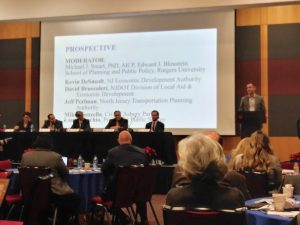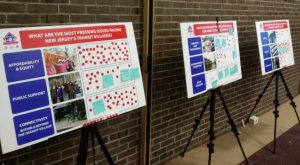New Jersey Future Blog
Celebrating the 20th Anniversary of New Jersey’s Transit Village Program
December 9th, 2019 by Tim Evans

Representatives from each of the Transit Villages were honored at the celebration.
Happy 20th birthday to New Jersey’s Transit Village program! The NJ Department of Transportation and NJ Transit jointly hosted an event on November 14 to commemorate the 20th anniversary of the Transit Village program, which incentivizes municipalities hosting transit stations (commuter rail, light rail, or major bus terminal facilities) to promote transit-oriented development (TOD). TOD puts homes, jobs, shopping, and other important destinations within walking distance of public transit to create an environment where a car is optional, not necessary.
The program has grown from the original five Transit Villages – Morristown, Pleasantville, Rutherford, South Amboy, and South Orange – to include 34 transit-hosting municipalities in almost every corner of the state. The event looked back on how the program has helped Transit Village municipalities capitalize on their transportation assets, and also looked forward toward the challenges and opportunities facing transit-hosting towns in the future.

Speakers presenting at the event
Municipal officials from some of the Transit Villages cited the program’s value as a marketing tool with which to attract developers. The “Transit Village” imprimatur serves to assure developers that this is the kind of place they’ve read about, where Millennials can find the “live-work-play” environment that they’re looking for, and where empty-nester Baby Boomers are looking to downsize into smaller “in-town” housing options. And it also signals to developers that local officials recognize their town’s strength as a transit-focused community and are looking for partners to help them build on that strength.
Looking ahead, panelists talked about the need to explore “micro-mobility” options like bike share and electric scooters to cover the “first mile/last mile” trip between the transit station and the traveler’s origin point or final destination. (Everyone is a pedestrian once they step off the bus or train; micro-mobility modes help shorten travel times and distances for people who would otherwise have to walk or take a taxi.) They also discussed the issue of housing affordability, and how to take advantage of growing market demand for transit-oriented living by providing enough new housing to absorb new residents without creating upward pressure on home prices and rents that might displace long-time residents.

Some of the most pressing issues facing New Jersey’s Transit Villages are affordability and equity, public support, and connectivity.
Given that so much of the state’s recent population growth is taking place in transit-friendly places, New Jersey Future would like to see even more municipalities join the Transit Village program. Since “the great reset” around 2008, demand for living near transit has taken off. Prior to 2008, municipalities hosting transit stations were growing much more slowly than the rest of the state. Transit stations are mostly located in older towns and suburbs that were built before the automobile rose to be the dominant form of transportation. Many of these transit-hosting towns saw their populations stagnate or even decline when car-oriented suburbia became the default development paradigm, starting in the 1950s and lasting well into the first decade of the new century. But now, they find themselves on the receiving end of a new round of demand for in-town living. State agencies should provide whatever assistance and incentives they can to transit-hosting towns, to make sure these towns continue to be able to accommodate potential new residents who are looking to avail themselves of all the benefits TOD offers.
















